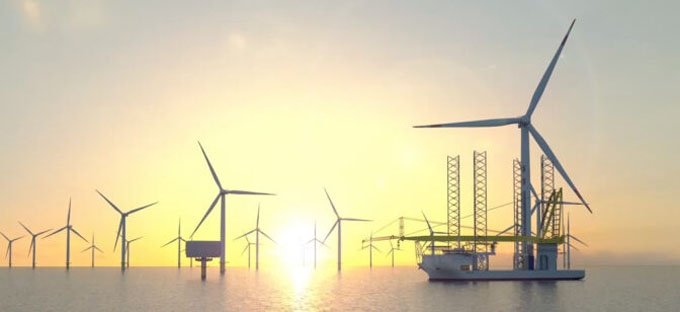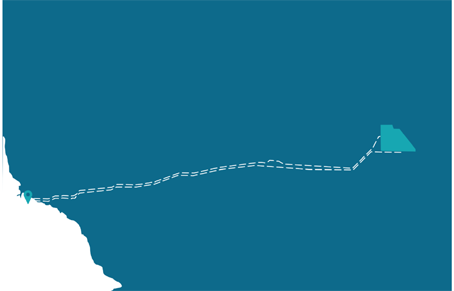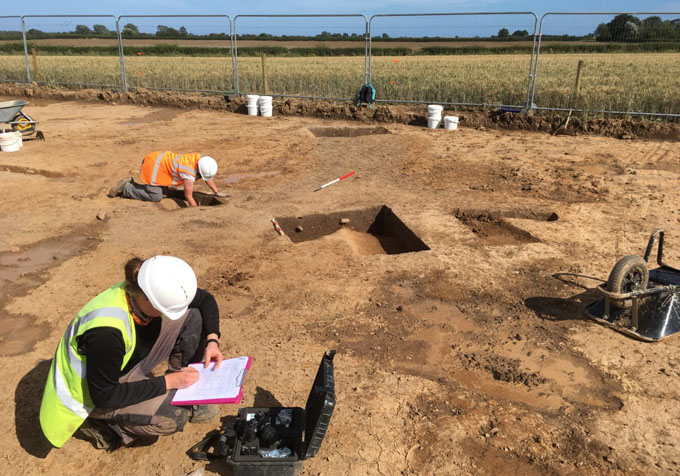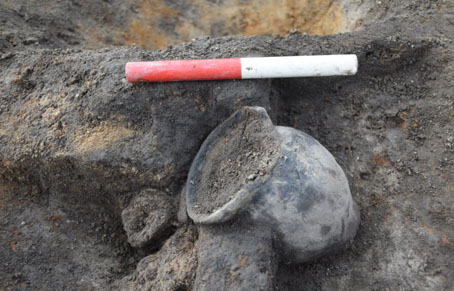
Dogger Bank Wind Farm is an offshore wind farm being developed in three phases – Dogger Bank A, B and C – located between 130km and 190km from the North East coast of England at their nearest points.
Collectively they will become the world’s largest offshore wind farm.
Each phase will have an installed generation capacity of 1.2GW and represents a multi-billion pound investment. Combined, they will have an installed capacity of 3.6GW and will be capable of powering around 6 million homes annually.
Dogger Bank is an isolated sandbank within the central to southern North Sea spanning UK, German, Danish and Dutch waters.
Research and the evidence of human activity, vegetation and the remains of mammals indicates that the general area was for a period of time a land mass connecting the UK to mainland Europe, known as Doggerland.
As the sea level rose after the last glaciation (ice age) the area gradually became an island before being completely covered by water some time between 8000 and 5500 years ago.
The Dogger Bank Offshore Development Zone, located between 125 and 290km off the east coast of Yorkshire, extends over approximately 8660km² and water depths range from 18m to 63m.

Dogger Bank A
The first phase of Dogger Bank Wind Farm is Dogger Bank A, which is located around 131km from shore at its closest point and has a development area of around 515km².
Upon completion it will have an installed generation capacity of 1.2GW.

Dogger Bank B
The largest of the project phases, with a development area of around 599km², is also around 131km from shore at its closest point.
Dogger Bank B will also have an installed generation capacity of 1.2GW.
Dogger Bank A and B, with a combined generation capacity of 2.4GW, will connect in to the existing Creyke Beck substation near Cottingham in the East Riding of Yorkshire.
The subsea export cables will make landfall to the north of Ulrome. From there, around 30km of underground cables will take the electricity to our 2 converter stations near to Cottingham before passing through the adjacent Creyke Beck substation on to the National Grid.

Dogger Bank C
Dogger Bank C, also with an installed generation capacity of 1.2GW, has a development area of around 311km², and is 196km from shore.
Connection will be at the existing Lackenby Substation at Teesside.
Dogger Bank D
Dogger Bank D has a capacity of up to 1.5GW of renewable electricity, harnessing the power of offshore wind.
Dogger Bank D is being developed by a 50 / 50 joint venture between SSE Renewables and Equinor. The Project is being developed at a crucial time for the UK’s energy sector. With advancements in offshore wind technology, the power from homegrown, clean renewables has the potential to ensure the UK can transition to a secure and affordable energy system.
The project has come forward through an opportunity which was identified to maximise the capacity from the eastern part of the original Dogger Bank C site.
Dogger Bank D welcomed confirmation of a grid connection location in February 2024. The wind farm will connect into Birkhill Wood, a proposed new 400kV substation located in the East Riding of Yorkshire which will be developed and constructed by National Grid Electricity Transmission (NGET) and does not form part of the Dogger Bank D proposals.
The proposed Dogger Bank D wind farm would be located in the eastern zone of the Dogger Bank C lease area, maximising the capacity of the existing acreage.
The team behind Dogger Bank D
Dogger Bank D is being developed by a 50/50 joint venture between SSE Renewables and Equinor, two of the world’s leading companies in the development and operation of offshore wind energy. Both companies were involved in the design and planning consent of Dogger Bank Wind Farm, the world’s largest offshore wind farm.
An announcement was made in February 2023 that Dogger Bank D was being explored as a proposed new fourth phase of the Dogger Bank Wind Farm, maximising the capacity of the eastern portion of the original Dogger Bank C area. As a Nationally Significant Infrastructure Project (NSIP), it will require a new Development Consent Order to facilitate the development, construction and operation of the proposed project.
Dogger Bank D is working closely with The Crown Estate who manage the seabed around England, Wales and Northern Ireland to agree the progression of the Project.
History
In 2008, the Crown Estate opened its third licence round for offshore wind which included the Dogger Bank Zone, located between 125 and 290km off the east coast of Yorkshire.
The zone extended over approximately 8660km² and was the largest zone in that licence round. With water depths ranging from 18 to 63 metres it was also one of the shallowest.
The consortium
Forewind, a consortium between SSE, Equinor, Statkraft and innogy, identified four project areas within the zone to take to development consent with each project area having up to 1.2GW of generation capacity.
At the time, the projects were named Creyke Beck A, Creyke Beck B, Teesside A and Teesside B.
During 2015, after around five years of careful assessment, development and engagement, all four project areas received planning consent from the UK Government.
At the beginning of 2017, Equinor (then Statoil) increased its share from Statkraft and in August 2017 new ownership arrangements were confirmed:
SSE and Equinor would progress the Creyke Beck A, Creyke Beck B and Teesside A projects under the new name of Dogger Bank Wind Farm, with each partner having 50% ownership and them being built in three phases.
All three phases were successful in the UK Governments 2019 Contract for Difference (CfD) auction.
To recognise their link to the historic Doggerland area, the three phases are now known as:
- Dogger Bank A (formerly Creyke Beck A)
- Dogger Bank B (formerly Creyke Beck B)
- Dogger Bank C (formerly Teesside A)
In February 2021, Eni Plenitude acquired a 20% ownership of the Dogger Bank A and Dogger Bank B phases with SSE Renewables and Equinor each retaining a 40% share.
In February 2022, Eni Plenitude acquired a 20% ownership of Dogger Bank C with SSE Renewables and Equinor maintaining 40% stakes each.
In October 2022, Vårgrønn, a joint venture between Plenitude and Norwegian company HitecVision acquired Plenitude’s 20% stake in Dogger Bank A, B and C.
SSE Renewables is leading on the development and construction of Dogger Bank Wind Farm, and Equinor will operate the wind farm on completion for its expected operational life of around 35 years.
RWE is progressing the Teesside B project which has been renamed Sofia Offshore Wind Farm.
Archaeology
During the construction of Dogger Bank Wind Farm, archaeologists have unearthed significant evidence of Anglo-Saxon presence in Holderness.
The ground-breaking early medieval discoveries were unearthed on the 30km corridor that houses the underground cables transmitting renewable energy from Dogger Bank Wind Farm in the North Sea, to the wind farm’s two onshore convertor stations off the A1079 near Beverley, East Riding of Yorkshire.

Archaeologists have unearthed significant evidence of Anglo-Saxon presence in Holderness. Image source: AOC Archaeology
These significant discoveries include remnants of an Anglo-Saxon long hall structure between Beeford and Skipsea, and an Iron-Age or Anglo-Saxon glass bead recovered from a site in Ulrome. The two sites close to Beeford produced the most evidence for Anglo-Saxon activity.
Radiocarbon dating of the activity on these sites is ongoing, but at the moment an area of 5th-6th century activity associated with metalworking has been identified, close to a separate area where a long hall and field system ditches were recorded. The findings indicate Anglo-Saxons probably lived and farmed in this landscape over multiple phases between the 5th-11th centuries.
Radiocarbon dating is a scientific method for accurately determining the age of organic materials, by analysing the decay of radioactive isotopes. The developers of the windfarm have invested in this technique to ensure the project provides local communities and historians with accurate data about how the land was used hundreds of years ago.

A 6,000 year old flint arrowhead. Image source: AOC Archaeology

Intact pottery in situ, thought to be more than 2,000 years old. Image source: AOC Archaeology
Across the pipeline route archaeologists also discovered Iron Age and Roman evidence including well-preserved roundhouses in Ulrome, Beeford and Leven, a long-handled bone comb in Leven and significant amounts of handmade and wheel-thrown pottery.
It has long been clear the Holderness area was inhabited by the Anglo-Saxons due to the names of the towns and villages in the area, many of which incorporate Anglo-Saxon elements. Over recent years archaeological evidence has begun to emerge of Anglo-Saxon activity in the landscape, and the findings near Beeford add significantly to an emerging picture of Anglo-Saxon life in the region, greatly enhancing understanding of the period in Holderness.
The evidence for domestic and industrial activity that was unearthed at the sites, which has been evaluated and confirmed by medieval specialists, is of particular importance and significance. Since the excavations at Beeford, a team of experts from York University has excavated a nearby site in Skipsea, further confirming the presence of Anglo-Saxons in the local area, centuries ago.
The partners
Dogger Bank is being developed in three 1.2GW phases : Dogger Bank A, B and C.
It is a joint venture partnership between SSE Renewables (40%), Equinor (40%) and Vårgrønn (20%).
SSE Renewables is leading on the development and construction of Dogger Bank Wind Farm, and Equinor will operate the wind farm on completion for its expected operational life of around 35 years.
SSE Renewables
SSE Renewables is a leading developer and operator of renewable energy generation, focusing on onshore and offshore wind, hydro, solar and battery storage.
Part of energy infrastructure company SSE plc, UK-listed in the FTSE100, it is delivering clean power assets to increase SSE’s operational renewable generation capacity from 5GW today to up to 9GW by 2027 as part of a ~£20bn clean energy plan, the five-year Net Zero Acceleration Programme (NZAP) Plus.
This includes delivery of the Dogger Bank Wind Farm.
SSE Renewables has a team of over 2,000 renewable energy professionals with a passion for championing clean energy delivery, each based across the markets in which it operates.
Its core market focus is on the UK and Ireland, with a growing international presence in carefully selected markets in Continental Europe and Japan.
Equinor
Equinor is the UK’s leading energy provider, supplying electricity, natural gas and oil, and aims to reach net zero emissions globally by 2050. A broad energy company, Equinor has been operating in the UK for nearly 40 years. Headquartered in Norway, the company employs 22,000 people globally, and over 650 in the UK. Equinor supports the UK economy by investing billions in crucial energy infrastructure, working with over 700 suppliers across the country.
Equinor has plans to reach an installed net capacity of 12-16 GW of renewable energy by 2030, with two-thirds of this capacity coming from offshore wind.
Equinor currently operates two offshore wind farms off the East Coast of England, Dudgeon and Sheringham Shoal. The company is a pioneer in floating wind technology and has installed the world’s first wind farm, Hywind Scotland, off the coast of Peterhead. Hywind Scotland is combined with Batwind, the world’s first co-located storage facility for an offshore wind farm. In partnership with SSE Renewables and Eni Plenitude, Equinor is building the largest offshore wind farm in the world, Dogger Bank, off the North East coast of England.
Vårgrønn
Vårgrønn is an agile, Norway-based offshore wind company powering the energy transition through development, construction, operation, and ownership of renewable energy generation and green infrastructure.
Vårgrønn is a joint venture between the energy company Plenitude (Eni) and the Norwegian energy entrepreneur and investor HitecVision.
Both companies have a long history in the offshore energy sector and are strongly committed to contributing to the energy transition.
Vårgrønn provides unique offshore competence, financial expertise and entrepreneurial drive.
KeyFacts Energy: Equinor UK country profile l SSE UK country profile
KeyFacts Energy Industry Directory: Vårgrønn
 KEYFACT Energy
KEYFACT Energy